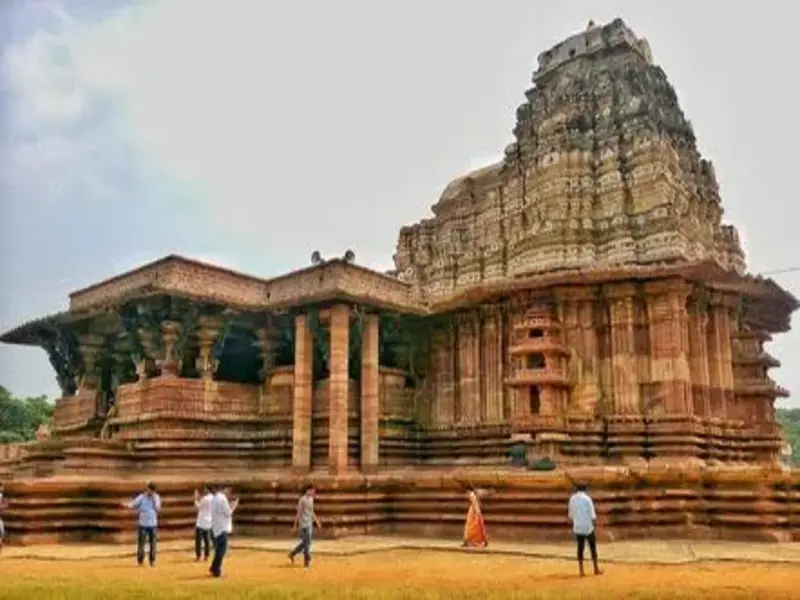The 13th-century Ramappa Temple in Mulugu in Telangana, a UNESCO World Heritage Site, grapples with 21st-century issues like pollution, encroachment, and inadequate preservation. Despite its historical significance, local authorities struggle to manage increasing tourist footfall, causing structural concerns. Experts urge immediate action to protect the temple’s intricate Kakatiya-era craftsmanship from modern-day threats.
Union Ministry for Culture has announced projects worth ₹3,295 crore for developing historical sites in the country, including the 13th-century Kakatiya Rudreshwara Temple, aka, Ramappa temple. The vimana, a jugalbandi of Dravidian architecture and Nagara Bhumija styles, stands tall, visible from a distance. The stepped horizontal tower proclaims the once flourishing Kakatiya architecture in Mulugu, the land of legendary mother-daughter duo Sammakka and Saralamma.
The Ramappa Temple also called Rudreshwara Temple located some 215 km from Hyderabad, received the UNESCO World Heritage Site tag in 2021. On November 28, Union Minister for Culture Gajendra Singh Shekhawat announced projects worth ₹3,295 crore for developing historical sites in the country, including the 13th-century Kakatiya Rudreshwara Temple. The temple stands as a testament to the elegance of Kakatiya architecture. However, some issues have been dogging the temple.
A testament to Kakatiya architecture
Built in 1134, the temple is named after Ramappa, a sculptor, for his contributions to the design. Dedicated to Lord Shiva, a variety of materials, ranging from granite floorings and basalt pillars to light brick ceilings and sandstone foundations have been used to construct the temple. Telangana’s 13th century Ramappa Temple is set to be developed with ₹73 crore from the Union government.
Uma Shankara Swamy is a priest who’s been working at the temple for over two decades now. “The whole temple is awe-inspiring. Its intricate sculptures and history made it deserving candidate for UNESCO recognition,” he opined. “Even in the sanctum santorum, the builders made sure to make it as illuminated as the rest of the temple. The temple attains its full glory during the Shivaratri celebrations each year,” he told #hydkhabar.
Travel and accommodation woes
Shankar identified some of the problems that visitors often face. “Transport is one of the major challenges for the temple. There are not many buses plying the route to Palampet. Additionally, it would be highly beneficial if they could arrange for cottages around the temple complex,” he suggested.
The priest added that the development works need not interfere with the temple complex.
“Whatever works they do, it should be outside the temple complex to protect its identity,” he said. Additionally, he noted that there was also work to be done in providing better power and water connectivity in the surrounding areas.
Similarly, Abhyakta, a devotee from Warangal, said not much information was available about the temple. “It makes me happy to see the temple develop so much in the last 10 years,” she opined. The woman has been visiting the temple regularly for the past decade.
“It would be great if there were boards around the complex explaining the history and the thought that went behind the structure,” she suggested.
Recently, the temple also witnessed an influx of treasure hunters who dug up a sub-shrine in hopes of finding something valuable. Following the incident in September this year, the Mulugu police also beefed up patrols in the area to protect the site from physical damage from treasure hunters.
Interest-free loan
The Union government released funds as an interest-free loan to develop the temple to Telangana under the Special Assistance to States for Capital Investment (SASCI) scheme. Operating under the Union Tourism Ministry, SASCI aims to develop iconic tourist centres on a global scale.
The released ₹73 crore came as part of about 40 other projects approved under the scheme across 23 states. In Telangana, the Somasila Wellness and Spiritual Retreat also received about ₹68 crore.
“When the funds come from the Centre instead of the state, the work progresses much slower in general,” Vikram (name changed), a caretaker of the temple, opined. Vikram is employed by the Archaeological Survey of India (ASI), which is responsible for the upkeep of numerous ancient monuments in India.
However, in the case of Ramappa Temple, the ASI is not responsible for its redevelopment. While the body is responsible for reviving the Tristhambham Gudi adjacent to the ancient temple, the state, specifically the Tourism Department, is responsible for developing the temple. #hydkhabar

